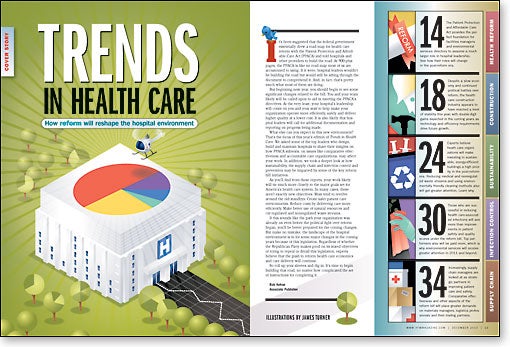Trends in Health Care
It's been suggested that the federal government essentially drew a road map for health care reform with the Patient Protection and Affordable Care Act (PPACA) and told hospitals and other providers to build the road. At 900-plus pages, the PPACA is like no road map most of us are accustomed to using. If it were, hospital leaders wouldn't be building the road but would still be sifting through the document to comprehend it. And, in fact, that's pretty much what most of them are doing.
Stay up on the trends |
| 2015's Health care facility trends |
| 2014's Health care facility trends |
| 2013's Health care facility trends |
| 2012's Health care facility trends |
| 2011's Health care facility trends |
| |
But beginning next year, you should begin to see some significant changes related to the bill. You and your team likely will be called upon to aid in meeting the PPACA's directives. At the very least, your hospital's leadership will count on you and your staff to help make your organization operate more efficiently, safely and deliver higher quality at a lower cost. It is also likely that hospital leaders will call for additional documentation and reporting on progress being made.
What else can you expect in this new environment? That's the focus of this year's edition of Trends in Health Care. We asked some of the top leaders who design, build and maintain hospitals to share their insights on how PPACA subtexts, on issues like comparative effectiveness and accountable care organizations, may affect your work. In addition, we took a deeper look at how sustainability, the supply chain and infection control and prevention may be impacted by some of the key reform bill initiatives.
As you'll find from these reports, your work likely will tie much more closely to the major goals set for America's health care system. In many cases, these aren't exactly new objectives. Most tend to revolve around the old standbys: Create safer patient care environments. Reduce costs by delivering care more efficiently. Make better use of natural resources and cut regulated and nonregulated waste streams.
If this sounds like the path your organization was already on even before the political fight over reform began, you'll be better prepared for the coming changes. But make no mistake, the landscape of the hospital environment is in for some major changes in the coming years because of this legislation. Regardless of whether the Republican Party makes good on its stated objectives of trying to repeal or derail this legislation, experts believe that the push to reform health care economics and care delivery will continue.
So roll up your sleeves and dig in. It's time to begin building that road, no matter how complicated the set of instructions for completing it.





